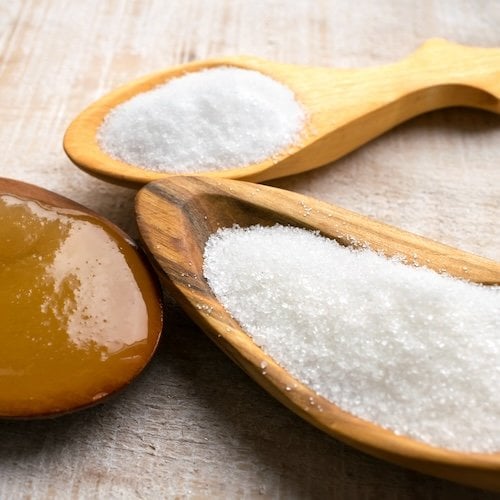Ask anyone who is working to lower their risk for or prevent complications of diabetes about the number one ingredient they want to avoid as much as possible. That is right – it is sugar. In particular, doctors and health experts have continuously recommended reducing excessive consumption of added sugars found in processed food and sweet treats due to their potential impact on blood sugar levels.,
But what about food choices that are naturally sweet and contain some types of sugar, such as fruits? When it comes to these options, moderation is definitely key. Aside from these choices, you can also consider workarounds in the form of sugar substitutes that will help you enjoy the sweet life (no pun intended) minus the guilt.
If you are looking for sugar substitutes that will not greatly impact your blood sugar levels, take note of these more natural options you can find in stores or online.
- Honey: This sweetener is less processed compared to sugar and tends to be digested easier. In some animal studies, usage of honey in lieu of sugar led to multiple effects such as reduced weight and blood sugar levels.
However, if you’re planning on using honey as a sugar substitute, remember that less is more. Research indicates that honey contains more calories than sugar. Moreover, if you have diabetes or are insulin-resistant, take note that honey can affect your blood glucose levels just like sugar, albeit at a slower pace.
Lastly, do not give honey to children 12 months old and below to avoid cases of botulism. This is a rare but potentially life-threatening issue caused by dust spores found in honey.
- Agave nectar or syrup: This sugar substitute is a brown liquid derived from the plant of the same name that is native to Mexico.
One advantage of agave is its low glycemic index (GI) since it has more fructose compared to glucose. The GI value refers to how slow or fast certain food choices cause increases in blood sugar levels — the higher the value, the more rapid the rise in blood sugar levels. Agave is known to have a low GI value (within the 10 to 27 range).
However, agave tends to be sweeter compared to sugar, so just like with honey, remember that less is more. It also contains high amounts of fructose that can be detrimental to your body if consumed in large amounts. So just like with other sweeteners, agave is best consumed in moderation.
- Stevia: Said to be 50 to 350 times sweeter compared to sugar, this sweetener is made from the leaves of the Stevia rebaudiana (Bertoni) plant that can be found in South America. It is gaining popularity because it does not have calories. If you are interested in trying stevia, you can look for it in various supermarkets or retailers.
- Fresh fruits: These are some of the best ways to add some sweetness into your meals. Fresh fruits contain lots of nutrients that can boost your health.
Do remember though that NOT ALL fruits are suitable for people with diabetes though. Some options still contain high amounts of sugar that can increase blood sugar levels and raise your risk for complications.
Ideally, if you have diabetes or want to reduce your risk for diabetes, opt for fruits with low or medium GI values.
As mentioned earlier, GI values indicate the speed at which glucose in certain food can affect blood glucose levels. Fruits with low or medium GI values may have minimal impact on your blood sugar levels since glucose tends to be released more slowly. Examples of low or medium GI fruits include:
- Low GI fruits: apples, cherries, strawberries, and pears
- Medium GI fruits: mangoes and oranges
More than knowing which fruits have low or medium GI values, be mindful of portions too. As much as possible, do your research on recommended serving sizes for particular fruits. It is possible that you may consume more than the recommended serving size. Even if you consume low- or medium-GI fruits, if this is done excessively, it will be counterproductive for your health.
Lastly, consult a doctor or dietitian prior to eating these fruits to know about the ideal portions you should be consuming daily. Do remember that even if these fruits can be healthy for you, overconsuming them can lead to health risks.
How About Other Artificial Sweeteners?
You can also encounter artificial sweeteners such as aspartame, saccharin, or sucralose. Much like the other sweeteners in the list above, they can be considered alternatives because they taste sweet, but are not loaded in calories.
However, be aware that there are also risks linked to artificial sweeteners. Findings of certain studies have revealed that these certain amounts of these sweeteners may change the composition and function of gut microbiota or even raise BMI levels or cardiovascular disease risk in certain individuals.
Overall, if you plan on using any of these artificial sweeteners or sugar substitutes more often, it is best that you control your intake of these and mind your portions. Ideally, talk to a doctor or dietitian first before using any of these sugar substitutes. These sugar substitutes can impact people’s bodies in different ways. Some people would react well to these sugar substitutes, while others may not.
Any of these health professionals can look into detail the ideal amount of these sugar substitutes you should be consuming or taking on a daily basis. They can also suggest other potential strategies that can help you curb sugar cravings.
References:
https://www.ncbi.nlm.nih.gov/pmc/articles/PMC5817209/
https://www.ncbi.nlm.nih.gov/pmc/articles/PMC4890837/
https://www.ncbi.nlm.nih.gov/pmc/articles/PMC7817779/
https://www.ajol.info/index.php/ajfand/article/view/163660
https://academic.oup.com/jn/article/148/7/1186S/5049670
https://www.bmj.com/content/378/bmj-2022-071204
https://www.cmaj.ca/content/189/28/E929
https://www.medicalnewstoday.com/articles/311220#fruits-to-include
https://www.medicalnewstoday.com/articles/317728#Benefits-of-honey
https://www.healthline.com/health/type-2-diabetes/diabetes-stevia
https://www.healthline.com/nutrition/agave-nectar-is-even-worse-than-sugar#production
https://www.healthline.com/nutrition/monk-fruit-sweetener
https://www.healthline.com/health/diabetes/low-glycemic-fruits-for-diabetes
https://www.healthline.com/nutrition/14-ways-to-eat-less-sugar
https://www.mayoclinic.org/diseases-conditions/diabetes/expert-answers/diabetes/faq-20058487
https://www.verywellhealth.com/sugar-replacements-for-diabetics-1087191
https://health.clevelandclinic.org/are-artificial-sweeteners-safe-for-people-with-diabetes/








